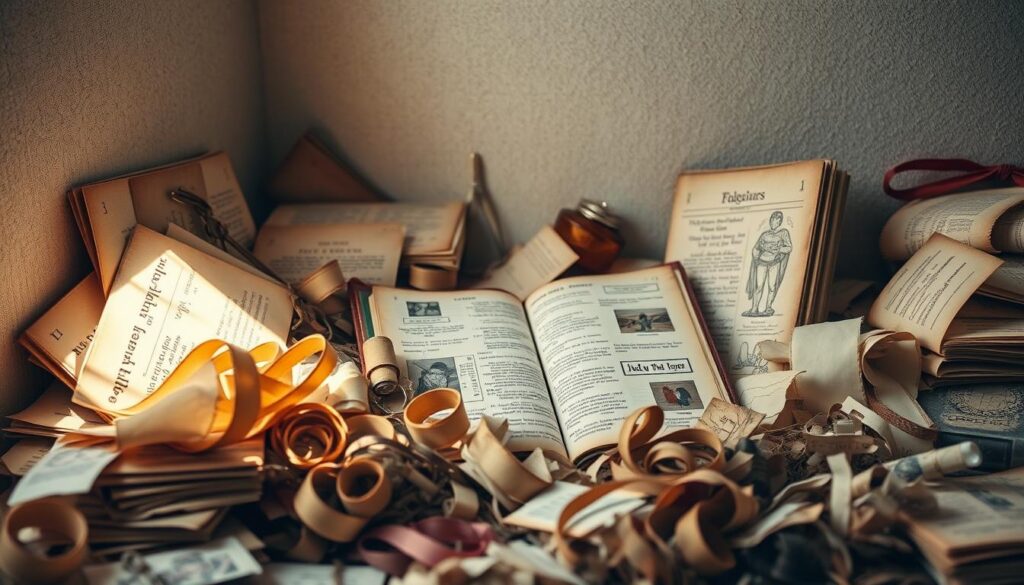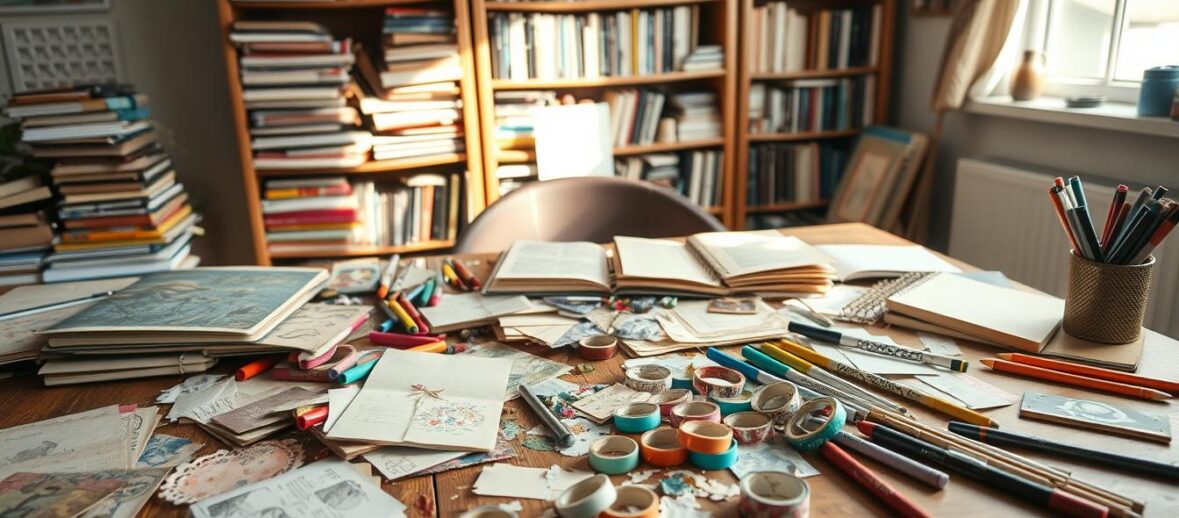Ever wanted to keep memories in a way beyond photo albums? Welcome to junk journaling and scrapbooking. It’s a world where your stories shine through mixed media art1. These crafts turn simple moments into special keepsakes that tell your story.
Junk journaling is more than a hobby; it’s a journey of storytelling and creativity. You mix found objects, recycled stuff, and personal items to make a unique memory book2. Each page is a chance to share your memories1.
Scrapbooking and junk journaling let you document your life in your own way. They’re great for keeping family history or celebrating big moments. You’ll find there are no hard rules, just endless ways to be creative2.
Key Takeaways
- Junk journaling combines mixed media art with personal storytelling
- No formal rules restrict your creative approach
- Materials can include recycled and found objects
- Perfect for preserving memories and personal experiences
- Suitable for crafters of all skill levels
Understanding the Art of Mixed Media Memory Keeping
Mixed media art brings a vibrant, personal touch to memory keeping, beyond just scrapbooking. It turns everyday moments into stunning stories3. Since the 19th century, people have kept memories by collecting items like ticket stubs and letters3.
Today, we mix old and new ways to document our lives. Junk journaling and scrapbooking are special ways to tell your story through mixed media4. They turn simple materials into powerful keepsakes.
Creative Documentation Approaches
There are many ways to keep memories, each with its own charm:
- Scrapbook pages on 12×12″ archival-quality papers4
- Handmade junk journals with many materials4
- Artistic layouts with personal items5
The Evolution of Memory Preservation
Memory keeping has grown from simple photo albums to detailed mixed media projects. Online communities have made these methods more popular3. Sites like Instagram and Pinterest show off countless journal spreads, inspiring people everywhere.
Blending Traditional and Modern Techniques
Your journal can mix different styles. You can use old magazines, fabric scraps, and digital elements in mixed media memory keeping3. It’s not just about keeping memories; it also helps with stress and mindfulness3.
Memory keeping is an art of personal storytelling, where every page reflects a unique moment in your life.
Essential Tools and Materials for Getting Started

You don’t need to spend a lot to start paper crafting. Begin with items you likely have at home6. A beginner might start with a small craft drawer. It will grow as your creativity does7.
Here are the basic tools you’ll need for your project:
- Scissors and craft knives6
- PVA glue (like Elmer’s) for sticking things together6
- Craft paper pads (often on sale for as low as $5)7
- Washi tape for adding a decorative touch7
Look for affordable materials:
- Craft paper from local stores
- Ephemera packs from online marketplaces7
- Vintage photographs and stamps from your own collection6
Choose colors like Tim Holtz distress oxides in vintage photo and walnut stain for a vintage look7. Remember, the beauty of junk journaling lies in creativity and personal expression.
Pro tip: Start with what you have and gradually build your collection of crafting supplies.
Junk Journaling and Scrapbooking: Key Differences and Similarities
Crafting memories through art journaling offers many ways to keep your personal stories. Scrapbooking and junk journaling might look similar, but they have their own creative ways to document life’s moments8.
Creative Expression Styles
Junk journaling is all about being free and eclectic. It lets you turn everyday items into art that keeps memories alive8. Scrapbooking, on the other hand, follows a more set design9.
- Junk journaling: Emphasizes creativity and spontaneity
- Scrapbooking: Focuses on organized photo preservation
- Both crafts: Celebrate personal storytelling
Material Usage Approaches
Your choice of materials shapes your memory book’s look. Junk journals use recycled items and affordable stuff8. Scrapbooks, however, go for better, longer-lasting materials10.
| Characteristic | Junk Journaling | Scrapbooking |
|---|---|---|
| Material Source | Recycled/Found Objects | New Crafting Supplies |
| Size Variation | Highly Flexible | Standard Sizes (12×12, A4) |
| Cost | Low-Cost | Variable Pricing |
Documentation Methods
Both crafts have special ways to capture memories through collage making and personal stories9. Whether you like scrapbooking’s structure or junk journaling’s freedom, your creativity is key8.
The beauty of these crafts is their flexibility. Many mix elements from both, making memory-keeping projects that show their unique artistic vision10.
Creating Your First Journal Base
Starting your junk journaling journey is an exciting adventure. Your first journal base doesn’t have to be perfect. It’s all about showing off your unique style and creativity11. Most beginners use basic supplies they already have at home. This makes the craft very accessible12.
To start your junk journaling journey, gather these essential materials:
- Cardboard or old book covers
- Assorted paper types
- Scissors
- Glue or adhesive
- Decorative elements like vintage tickets or fabric scraps12
Creating your journal base is simple. About 70% of new junk journalers suggest learning basic techniques. These include cover making and signature stitching11. Remember, this craft loves imperfection and personal expression!
| Supply | Estimated Cost |
|---|---|
| Mixed Paper Pack | $8 |
| Vintage Sticker Set | $6 |
| Blank Notebook | $15 |
About 75% of junk journal makers use materials they already have at home11. Your journal can include personal mementos. Think movie tickets, dried flower petals, or old postcards. This makes each creation truly unique12.
Pro tip: Don’t be afraid to experiment and let your creativity flow!
Paper Selection and Treatment Techniques
Making a unique junk journal starts with picking the right paper and treatment methods. Your journey will turn simple materials into special vintage embellishments that share your story13. Using creative paper techniques adds depth and character to your work14.

- Texture variations
- Weight and durability
- Potential for aging and distressing
- Compatibility with different staining methods
Aging and Distressing Approaches
Vintage paper treatment includes many creative methods. You can get a real, weathered look by:
- Coffee staining
- Tea bath aging
- Sandpaper distressing
- Ink and paint weathering
Staining Processes
Coffee and tea staining can change your paper a lot. Brew a strong pot of coffee or steep multiple tea bags to get the look you want. Try different soaking times to control how aged your paper looks1.
“The magic of junk journaling lies in transforming ordinary materials into extraordinary memories.”
Learning these paper techniques opens up endless ways to make unique, personal journals. These journals will show off your creative side13.
Organizing Your Creative Space
Starting your creative journey in journaling and paper crafting needs a well-organized space. Your crafting area should be a place that inspires you and keeps your stuff within reach15. Think about getting storage that makes your space more efficient, like portable cases for all your supplies15.
Here are some important tips for organizing your creative space:
- Use 12 x 12 inches project boxes for storing scrapbook papers15
- Utilize 5 x 7 inches photo cases for small cut-outs and phrases15
- Implement a regular purging system to keep supplies current15
For those who love paper crafting, keeping things organized is key. Make a plan to check your supplies every 2-4 weeks15. This helps you decide what to keep and what to toss, keeping your space tidy and your workflow smooth.
Pro tip: Join online groups like Facebook groups with over 4,000 members who love art journaling15. You might find deals on organizing tools, with some stores offering up to 10% off15.
Remember, an organized space is an inspired space!
Incorporating Vintage Elements and Ephemera
Vintage embellishments add magic to your junk journaling projects. They turn simple pages into amazing storytelling canvases. By using ephemera, you can tell rich stories with historical artifacts and nostalgic materials16.
When looking for vintage elements, you have many places to check. Crafters find amazing materials in different spots:
- Thrift stores (primary source for 65% of junk journalers)17
- Flea markets
- Online marketplaces
- Antique shops
- Family archives
Finding Authentic Vintage Materials
Your collection can include cool items like old postcards, letters, tickets, and advertisements. About 60% of crafters use vintage papers as main materials in their journals17. Antique postcards and photos are especially loved, with 75% of fans adding them for personal stories17.
Creating Vintage-Style Elements
You don’t always need real vintage items. Techniques like tea staining can age modern materials, used by 55% of crafters17. Try burnishing, distressing paper edges, and vintage-inspired stamps for that classic look.
Pro tip: Always use acid-free storage solutions to preserve your vintage ephemera and protect your cherished memories.
Remember, adding vintage elements is more than collecting. It’s about making deep connections to history and personal stories16.
Conclusion: Embracing Your Creative Journey
Your creative journaling adventure is about to start, filled with endless possibilities. It’s a special way to express yourself and keep memories alive through your own stories. Studies show that doing these crafts can really boost your mental health, with 60% of people feeling happier18.
Memory keeping is more than just recording moments. It’s an art that lets you deeply connect with your experiences. Junk journaling has grown from a small hobby to a worldwide movement. It draws people from all walks of life who love hands-on creative activities19. About 70% of creators mix old materials with new ones, making each journal a unique work of art18.
Starting your journey, remember there are no hard rules. Your journal shows your creativity, feelings, and style. Whether you want to relax, express yourself, or keep your life’s stories, junk journaling is a healing way to find joy and fulfillment18. Embrace the imperfections, try new things, and most importantly, enjoy making something that’s all yours.
FAQ
What exactly is junk journaling?
Do I need expensive supplies to start junk journaling?
What’s the difference between junk journaling and traditional scrapbooking?
How do I age paper for my junk journal?
Where can I find vintage ephemera for my projects?
Is there a “right” way to create a junk journal?
How can I organize my junk journaling supplies?
Can digital enthusiasts enjoy junk journaling?
Source Links
- Combine Your Journal with Your Scrapbook with This Easy Technique – The Olden Chapters – https://theoldenchapters.com/beginners-guide-junk-journaling/
- What is a Junk Journal? Junk Journaling 101 for Beginners – https://artjournalist.com/what-is-a-junk-journal/
- How to Use Junk Journaling for Memory Keeping – Craft and Cherish – https://craftandcherish.com/junk-journaling-for-memory-keeping/
- What Is The Difference Between a Junk Journal and Scrapbook? – https://artsyfartsylife.com/difference-junk-journal-scrapbook/
- What’s the Purpose of a Junk Journal? – https://compassandink.com/whats-the-purpose-of-a-junk-journal/
- A Junk Journal Supplies List – Essentials For Beginners – https://www.thescrapologist.com/blogs/junk-journal-blog-1/my-junk-journal-supplies-list-for-beginners?srsltid=AfmBOoqLO4EeUcYm_iVT07Y_elnyqCGffz3hnHk_6CtGSsdD0GcflI50
- The Best Junk Journaling Supplies for Beginners – https://compassandink.com/junk-journaling-supplies-for-beginners/
- Junk Journaling vs Scrapbooking: Differences and Benefits – Craft and Cherish – https://craftandcherish.com/junk-journaling-vs-scrapbooking/
- Scrapbook vs Junk Journal – Are They The Same? – The Slowestuff Blog – https://slowestuff.com/scrapbook-vs-junk-journal/
- What’s The Difference Between Scrapbooking and Junk Journaling? – https://thecloakedfox.com/blogs/blog/what-s-the-difference-between-scrapbooking-and-junk-journaling
- How To Get Started With Junk Journaling – https://compassandink.com/how-to-start-junk-journaling/
- The Ultimate Guide: How To Create A Junk Journal – Style Meets Story® – https://stylemeetsstory.com/junk-journal/
- Junk Journaling Joy: How to Make Junk Journals Unique to You – https://stampington.com/somerset-place/junk-journaling/?srsltid=AfmBOoq02teQg1Qxwm-Ri_Aocv-gmjzaxFenoBfhL3y0jOmyrIvOJkDJ
- I Tried Junk Journaling For a Month—Here’s What Happened – https://www.verywellmind.com/i-tried-junk-journaling-for-a-month-11679873
- How to Organize Ephemera for Collage, Art Journaling & Junk Journals – https://artjournalist.com/how-to-organize-ephemera/
- What Is Junk Journaling and How To Get Started? – TheCasualReader – https://thecasualreader.com/what-is-junk-journaling/
- Storytelling with Vintage Elements in Junk Journals – Craft and Cherish – https://craftandcherish.com/storytelling-with-vintage-elements/
- What is Junk Journal? – https://medium.com/@persianstudygram/what-is-junk-journal-8763f7c10ce
- Unearthing the Fascinating Evolution of Junk Journaling – https://rusticplayground.com/unearthing-the-fascinating-evolution-of-junk-journaling/

